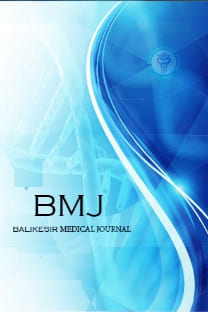Sezaryen doğumda üriner kateter çıkarma zamanlamasının üriner retansiyona etkisi
Amaç: Bu çalışmada sezaryen (CS) hastalarında 6, 12 ve 24 saat sonra çıkarılan idrar sondalarının ameliyat sonrası sonuçlarını ve üriner retansiyonlarını karşılaştırmayı amaçladık. Gereç ve Yöntemler: Bu prospektif çalışmaya önceden sezaryen ameliyatı olan ve bu endikasyon nedeniyle spinal anestezi altında elektif sezaryen uygulanan gebeler dahil edildi. Hastalar 1:1:1 oranında üç gruba ayrıldı ve 6,12 ve 24 saat sonra hastaların sondası çekildi. Rezidüel idrar miktarı ultrasonografi ile ölçüldü. Ayrıca ambulasyona kadar geçen süre, rekateterizasyon oranı, idrar yolu enfeksiyonu (İYE) semptomları ve hastanede kalış süreleri kaydedildi. Bulgular: 6 saat sonra kateteri çıkarılan grupta üriner retansiyonu oranı (13.9 %) anlamlı olarak daha yüksekti. İlk ambulasyona kadar geçen süre kateterin süresinden etkilenmişti ve kateteri 24 saat sonra çıkarılan grupta anlamlı olarak daha yüksekti (p=0.038). Ek olarak, 24 saat sonra kateteri çıkarılan grupta dizüri ve İYE anlamlı olarak daha yüksek izlendi. Ancak hastanede kalış süresi üç grup arasında benzerdi. Sonuç: Yarar-zarar dengesi göz önüne alındığında, CS’den 12 saat sonra kateterin çıkarılması önerilebilir. Ancak, yönetim bireyselleştirilmelidir.
Anahtar Kelimeler:
Sezaryen, üriner kateter, üriner retansiyon, idrar yolu enfeksiyonu, postoperatif komplikasyonlar
The effect of urinary catheter removal timing on urinary retention in cesarean section
Objective: In this study, we aimed to compare the postoperative outcomes and urinary retention rate of urinary catheters removed after 6, 12, and 24 hours in cesarean section (CS) patients. Materials and Methods: Pregnant women who had undergone term elective CS for previous CS indication under spinal anesthesia were included in this prospective study. Patients were divided into three groups in a 1:1:1 ratio and the patient’s urinary catheter was removed after 6, 12, and 24 hours. The residual urine amount was calculated with ultrasonography. In addition, the time until ambulation, recatheterization rate, urinary tract infection (UTI) symptoms, and the duration of hospitalization were recorded. Results: The urinary retention rate (13.9 %) was significantly higher in the group whose catheter was removed after 6 hours. The time to the first ambulation was affected by the duration of the catheter and was significantly higher in the group whose catheter was removed after 24 hours (p=0.038). Additionally, dysuria and UTI were seen significantly higher in the group whose catheter was removed after 24 hours. However, the length of hospital stay was similar between the three groups. Conclusion: Considering the benefit-harm balance, removal of the urinary catheter at 12 hours after CS could be suggested. However, the duration of urinary catheter removal should be individualized.
Keywords:
cesarean section, urinary catheter, urinary retention, urinary tract infection, postoperative complications,
___
- 1. Organization WH. WHO statement on caesarean section rates. World Health Organization, 2015.
- 2. M Tarney C. Bladder injury during cesarean delivery. Current women's health reviews. 2013;9(2):70-6.
- 3. Li L, Wen J, Wang L, Li YP, Li Y. Is routine indwelling catheterisation of the bladder for caesarean section necessary? A systematic review. BJOG : an international journal of obstetrics and gynaecology. 2011;118(4):400-9. 4. Abdel‐Aleem H, Aboelnasr MF, Jayousi TM, Habib FA. Indwelling bladder catheterisation as part of intraoperative and postoperative care for caesarean section. Cochrane Database of Systematic Reviews. 2014(4).
- 5. Basbug A, Yuksel A, Ellibeş Kaya A. Early versus delayed removal of indwelling catheters in patients after elective cesarean section: a prospective randomized trial. The Journal of Maternal-Fetal & Neonatal Medicine. 2020;33(1):68-72.
- 6. Aref NK. Does timing of urinary catheter removal after elective cesarean section affects postoperative morbidity?: a prospective randomized trial. The Journal of Maternal-Fetal & Neonatal Medicine. 2020;33(18):3141-6.
- 7. Menshawy A, Ghanem E, Menshawy E, Masoud AT, El-Sharkawy M, Taher A, et al. Early versus delayed removal of indwelling urinary catheter after elective cesarean delivery: systematic review and meta-analysis of randomized controlled trials. The Journal of Maternal-Fetal & Neonatal Medicine. 2020;33(16):2818-25.
- 8. El-Mazny A, El-Sharkawy M, Hassan A. A prospective randomized clinical trial comparing immediate versus delayed removal of urinary catheter following elective cesarean section. European Journal of Obstetrics & Gynecology and Reproductive Biology. 2014;181:111-4.
- 9. Hooton T, Bradley S, Cardenas D, Colgan R, Geerlings S. C Rice J, et al. 2010. Diagnosis. Prevention, and Treatment of Catheter-Associated Urinary Tract Infection in Adults. 2009.
- 10. Chai AH-L, Wong T, Mak H-LJ, Cheon C, Yip S-K, Wong ASM. Prevalence and associated risk factors of retention of urine after caesarean section. International Urogynecology Journal. 2008;19(4):537-42.
- 11. Kermans G, Wyndaele J, Thiery M, De Sy W. Puerperal urinary retention. Acta urologica belgica. 1986;54(4):376-85.
- 12. Liang C, Chang S, Chang Y, Chen S, Chueh H, Cheng P. Postpartum urinary retention after cesarean delivery. International Journal of Gynecology & Obstetrics. 2007;99(3):229-32.
- 13. Ballstaedt L, Woodbury B. Bladder post void residual volume. 2019.
- 14. Smith NK, Morrant JD. Post-operative urinary retention in women: management by intermittent catheterization. Age and Ageing. 1990;19(5):337-40.
- 15. Alessandri F, Mistrangelo E, Lijoi D, Ferrero S, Ragni N. A prospective, randomized trial comparing immediate versus delayed catheter removal following hysterectomy. Acta obstetricia et gynecologica Scandinavica. 2006;85(6):716-20.
- 16. Ahmed MR, Ahmed WAS, Atwa KA, Metwally L. Timing of urinary catheter removal after uncomplicated total abdominal hysterectomy: a prospective randomized trial. European Journal of Obstetrics & Gynecology and Reproductive Biology. 2014;176:60-3.
- Yayın Aralığı: Yıllık
- Başlangıç: 2017
- Yayıncı: Balıkesir Üniversitesi
Sayıdaki Diğer Makaleler
Ömer TOPRAK, Hacer ŞEN, Burcu YILDIRIM ÖZKAN, Sümeyye Hilal DOĞAN
Sezaryen doğumda üriner kateter çıkarma zamanlamasının üriner retansiyona etkisi
Burak ERSAK, Duygu TUĞRUL ERSAK, Burak ELMAS, Bergen LALELİ KOÇ, Mahmut Kuntay KOKANALI
PREDİYABET HASTALARINDA TOTAL BİLİRUBİN VE İSKEMİ MODİFİYE ALBÜMİN İLİŞKİSİ
Mehmet POYRAZER, Fatma KAPLAN EFE, Büşragül AKSOY YILMAZ, Rıdvan ERTEN, Gül GÜRSOY
Kronik Hepatit B Enfeksiyonu, Siroz ve Antiviral Tedavi İlişkili Sarı Ürtiker Olgusu
